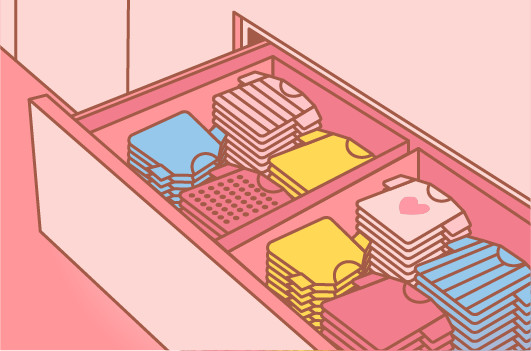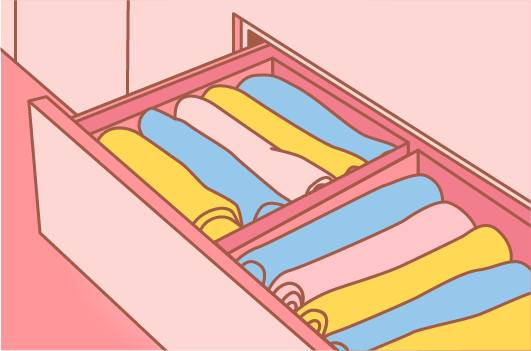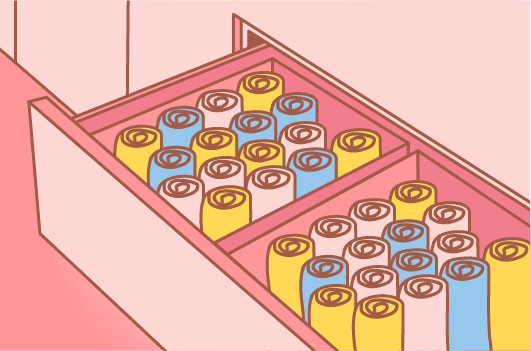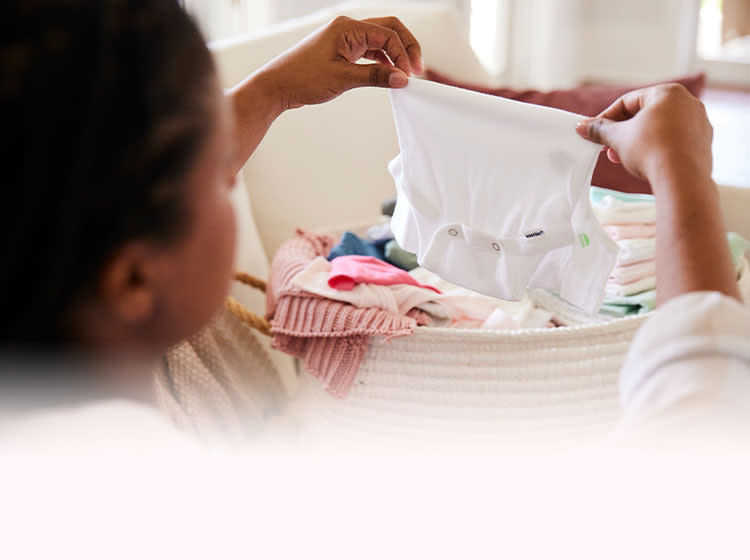How to Organize Baby Clothes with Different Folding Methods
Folding and organizing your baby’s clothes might seem like a hassle, especially with so much else to think about as a new parent, but it can save you time and energy in the long run by making outfit selections easier and giving the nursery a calmer, cleaner feel.
There are several different ways to fold baby clothes; here are a few of the most common.
Traditional folding method
This style of folding generally has you fold the odd corners of clothes until they resemble squares or rectangles, then stack them on top of each other in the drawer. It’s probably the folding style you grew up with. It might be the folding style you use now.
KonMari folding method
Another way to fold baby clothes that’s gained popularity in recent years is the KonMari folding method, which saves space and allows you to see all your clothing options at once. This involves folding clothes into a small parcel that can stand on its end, then “filing” the parcels away in the drawer. We’ll lay out the details of KonMari folding later in this article.
Rolling method
A third style you can use to organize baby clothes is to fold the clothes into long lines and then roll them up. Like KonMari, this method also allows you to pack many pieces of clothing into a small space and to see them all at once.
How to Fold Newborn Clothes
Some types of newborn and baby clothes are fairly straightforward to fold the flat, traditional way because they have the same shapes as their grown-up counterparts.
For example: to fold baby pants, first fold them in half vertically, so the two legs are together, then fold them at the knee to make a little rectangle that can easily be put away in a drawer. To fold a baby T-shirt, first fold the sleeves in behind the back, then fold the shirt in half at the chest. This is probably very similar to how you fold your own pants and tees.
Other items might give you more trouble due to a new shape, but if the purpose is to make the clothing items neat and organized in a drawer, then usually you can figure out how to turn any piece of clothing into a passable rectangle. In the case of cloth diapers, for example, fold in the tabs on the sides and then fold at the middle to make a neat bundle for stacking.
Below are some step-by-step instructions for how to fold several of the most common items of newborn baby clothing.
How to Fold Baby Onesies
Folding onesies using the traditional method is very simple:
If the onesie has long sleeves, fold them in behind the back. (If it has short sleeves, skip this step. Baby onesies are so small that it’s no big deal to have those tiny short sleeves sticking out.)
Fold the onesie in half horizontally, so it looks like a little T-shirt. Congratulations—you’re done!
How to Fold Baby Socks
Baby socks are folded just like you probably fold your own socks. There are just two steps:
Place the socks one on top of the other.
Turn down the cuff of one sock around both socks, securing them together.
What Clothes Should Be Hung?
Some baby clothes should not be folded. If your child has any “special occasion” clothing, like dresses or suits, those items should be hung in the closet to keep them from wrinkling. Outerwear, such as jackets and coats, is another category of baby clothing that’s often hung up instead of folded and put away in a drawer. Over time, you will develop a sense of what works best for you to fold and to hang—every family is different, after all. No matter what you choose to hang up, you will need little hangers designed for baby and toddler clothes. (You can ask for these on your baby registry.)
How to Fold Baby Clothes to Save Space
Another way to fold and organize clothes is the KonMari folding method, popularized by organizer Marie Kondo. The basic steps of KonMari folding and organizing for any clothing item are:
Fold items vertically, folding in any odd sticking-out bits like sleeves, until you have made a long, narrow rectangle out of the article of clothing.
Fold up this rectangle in thirds (or fourths, if that’s easier for you) until you have a small, compact bundle.
The little bundles are placed on their ends in drawers like files in a file cabinet.

So to fold a onesie using this technique, lay it flat on the table and fold in the sides, also folding down the sleeves so they run straight down the back. Then fold it in thirds or fourths to get that little bundle.


To fold baby pants using the KonMari method, first fold them in half, then fold until they have that thick bundle shape that will allow them to stand on end.


To fold a sleeper in KonMari style, fold in the sides so that each leg of the suit is folded in half vertically, fold the legs up at the knees, then fold over into a little bundle.
This vertical storage method allows you to save space and see everything you have of a particular type of clothing at once.

How to Fold Baby Clothes for Travel
Whatever your preferred folding method for baby clothes, if it works for home, it’s perfectly suitable for travel. But if you want to take your packing to a completely new level, then allow us to introduce … the outfit roll. The outfit roll is assembled as follows:
Gather everything you will need to make an outfit (pants, onesie, socks, accessories).
Stack all the outfit components (minus the socks) on top of each other.
Fold in any shirt sleeves, so the entire stack will make a compact cylinder when rolled up.
Position the socks on the stack so that their cuffs will stick outside the edges of the cylinder
Roll up the whole thing and turn the sock cuffs inside out to secure the edges. You now have a complete outfit in a small, secure package. Repeat as necessary for every outfit you will need for traveling.
There are plenty of different ways to fold baby clothes, and you should pick whatever feels simplest to incorporate into your life because baby laundry pretty much never stops! Many parents don’t bother folding at all. When creating a nursery, they use shelving that fits decorative bins inside, and they keep a bin for each type of clothing item. Whenever the laundry is done, they simply sort the clean clothes into their proper bins. While this method results in a bit of chaos inside each bin, you might decide it’s a price worth paying to never have to deal with folding tiny pants. Whatever organizational method works for you, make sure all your baby clothes are washed in Dreft, the #1 pediatrician recommended baby detergent brand!

